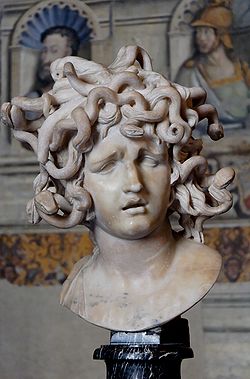- Medusa (Bernini)
-
Medusa 
Artist Gianlorenzo Bernini Year c. 1630s Type Marble sculpture Location Palazzo dei Conservatori, Rome Medusa is a sculpture of the eponymous character from the classical myth. It was executed by the Italian sculptor Gianlorenzo Bernini. Its precise date of creation is unknown, but it is likely to have been executed in the 1630s. It was first documented in 1731 when presented to the museum of the Palazzo dei Conservatori in Rome.
Contents
Story
The portrait draws on the myth of Medusa, the snake haired woman whose gaze could turn onlookers to stone. Unlike other depictions of the Medusa, such as Benevenuto Cellini’s Perseus and Medusa, the Medusa is not portrayed as a vanquished figure, her head severed from her body but as a living monster. Bernini’s decision to create a marble sculpture may be some kind of visual pun on the myth - creating a stone version of a living creature that could turn men to stone.[1]
Creation
Nothing is known about its creation, and parts of the sculpture’s execution undermine Bernini’s authorship of the sculpture, most notable the heavy, over-exaggerated eyebrows and the rough treatment of the snakes. Yet the sensual fleshy quality of the cheeks and lib, the polished precision of the face, the tormented face of the Medua and lively intelligence behind the literary concept and its unusual treatment point to the work of Bernini.[2]
Restoration
Considerable technical analysis and restoration of the sculpture took place in 2006.[3]
References
Categories:- 1630s works
- Sculptures by Gian Lorenzo Bernini
- Monuments and memorials in Italy
Wikimedia Foundation. 2010.
